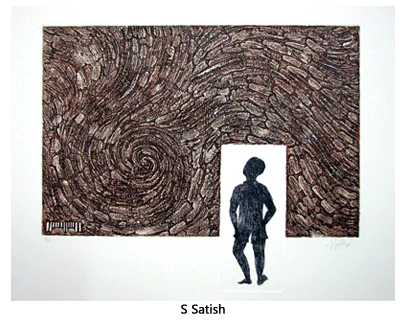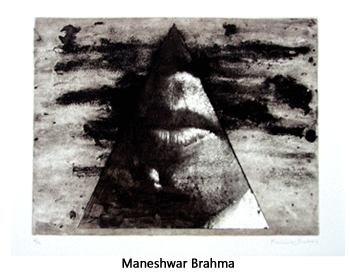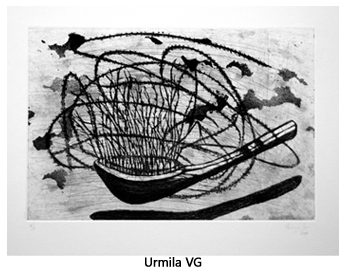- Prelude
- Editorial
- Subodh's 'return home'
- A Conversation with TV Santosh
- It's a War Out There
- Raqib Shaw
- Illusions in Red from a very British Indian Sculptor
- Stand Alone: Shibu Natesan
- Reading Atul Dodiya
- Bharti Kher: An Obsession for Bindis
- Bose Krishnamachari
- The Image - Spectacle and the Self
- From Self-depiction to Self-reference: Contemporary Indian Art
- GenNext: The Epitome of New Generation Art
- Kolkata's Contemporary Art A Look in the Mirror
- Innovation Coalesced with Continuing Chinese Qualities
- Kala Bhavana-Charukala Anushad Exchange Program
- Montblanc Fountain Pens
- Dutch Designs: The Queen Anne Style
- Bangalore Dance Beat
- Decade of change
- Distance Between Art & It's Connoisseur
- What Happened and What's Forthcoming
- 3rd India Art Summit
- New Paradigms of the Global Language of Art
- Black Brown & The Blue: Shuvaprasanna
- Art Events Kolkata
- Musings from Chennai
- Art Bengaluru
- Printmaker's Season
- Mumbai Art Sighting
- The Pause of Profound Stillness
- Previews
- In the News
- The Rebel Queen: An icon of her own times yet looked down upon
ART news & views
Printmaker's Season
Volume: 3 Issue No: 14 Month: 3 Year: 2011
North-East Opsis
by Moushumi Kandali
As new media proliferates and lines between genres in the contemporary art world dissolve, some quarters have started wondering -- what, and where is printmaking today…Some even raise a question as what is the value of keeping printmaking as a separate artistic category,  as in this technocratic world of today anyone with right software and a high tech colour printer can produce innumerable and infinitely reproducible images. However all do not necessarily support this line of thinking and printmaking in spite of its somewhat relegated status in the contemporary art practice of India continues vibrantly keeping alive its hundred years of fine legacy. That was what exactly felt by the print makers, artists and art lovers of north-east as they could participate and witness three consecutive camps of printmaking within the short span of one month held in the premise of Lalit Kala Wing of Srimanta Sankardeva Kalakhetra, a cultural complex of Guwahati in Assam, the three camps saw fine interaction and expositions of technical finesse and conceptual diversity where many artists hailing from all the north-eastern states and from other parts of India took part. In this continuous printmaking bonanza, the gracious presence of Jyoti Bhatt in one of the camp was the highlight. As we all know, in the pan Indian art scene, the 1960s and 70s brought to the fore printmakers like Jyoti Bhatt, who received his training in Baroda. Jyoti Bhatt went on to study at the Pratt Graphic Centre in New York, where he mastered the various techniques of intaglio printing. After his return in 1966, he started a relentless journey in this genre to create a very distinct idiom of his own by appropriating and re-appropriating elements, motifs, metaphors, symbols and ideas from the vast realm of visual tradition, systems of thoughts and holistic experiences of Indian life. Interacting and learning the technical and ideational aspects from such a veteran indeed had been a beneficial experience for the artists from North-east India. This was the third “Artist in residency and regional printmaking camp” in the chronological order which was held from 10th February to 17th February organised in collaboration by Kalakhetra and Lalit Kala Akademy regional centre, Kolkata.
as in this technocratic world of today anyone with right software and a high tech colour printer can produce innumerable and infinitely reproducible images. However all do not necessarily support this line of thinking and printmaking in spite of its somewhat relegated status in the contemporary art practice of India continues vibrantly keeping alive its hundred years of fine legacy. That was what exactly felt by the print makers, artists and art lovers of north-east as they could participate and witness three consecutive camps of printmaking within the short span of one month held in the premise of Lalit Kala Wing of Srimanta Sankardeva Kalakhetra, a cultural complex of Guwahati in Assam, the three camps saw fine interaction and expositions of technical finesse and conceptual diversity where many artists hailing from all the north-eastern states and from other parts of India took part. In this continuous printmaking bonanza, the gracious presence of Jyoti Bhatt in one of the camp was the highlight. As we all know, in the pan Indian art scene, the 1960s and 70s brought to the fore printmakers like Jyoti Bhatt, who received his training in Baroda. Jyoti Bhatt went on to study at the Pratt Graphic Centre in New York, where he mastered the various techniques of intaglio printing. After his return in 1966, he started a relentless journey in this genre to create a very distinct idiom of his own by appropriating and re-appropriating elements, motifs, metaphors, symbols and ideas from the vast realm of visual tradition, systems of thoughts and holistic experiences of Indian life. Interacting and learning the technical and ideational aspects from such a veteran indeed had been a beneficial experience for the artists from North-east India. This was the third “Artist in residency and regional printmaking camp” in the chronological order which was held from 10th February to 17th February organised in collaboration by Kalakhetra and Lalit Kala Akademy regional centre, Kolkata.  The participating artists were Sukla Sen Poddar, Ajit Seal, Ramendra Nath Kastha,( West Bengal), Wahengbam Khabemba Singh, Yumnam Sapha Wangam Apanthoi M, (Manipur) Dhwaja Devi Brahma, Ranjit Kumar Rabha (Assam), Sourav Deb Barma, Chinmoy Goswami,(Tripura) and Lalremruata Varte from Mizoram. The first camp was held by kalakhetra in collaboration with Lalit Kala Akademi, New Delhi from 23rd January to 29th January. The participating artists were Sivan G, Maneswar Brahma, Lalremruata Varte, Pangeranen Aier, Soumya Chakravarty, M Samson Meity, Ranjit Kumar Rabha, Thoidingjam Lokeswari Devi, Paltu Barman and Durgeswar Deka. The second camp was held from 6th February to 9th February with fifteen participating artists namely, Noni Borpujari, Dilip Tamuli, Urmila VG, Satish S, V Benugopal, Harish V, Prashad KG, Maneswar Brahma, Prabin Kumar Nath, Aditi Chakravarty, Niva Devi, Manika Gogoi, Upasana Bora and Chandan Bezbarua. The second camp which experimented in different media of printmaking such as etching, woodcut, digital print etc, was different compared to the other two as it was an independent initiative by some young printmakers on their own. Formed under a conceptual umbrella named “Diagonal Line,” it was an initiative of artists from Guwahati to Bangalore to Goa (the diagonal line!) to promote the art of printmaking in specific. The “Friendship” camp was the first of its attempt to set the ball in the court. As stated by one of the initiators Satish S, the foremost objective of the Group is to explore the possibilities of different media in this genre and spreading awareness about the less practiced and lesser known art of printmaking in the public domain. Apart from this specific objective, they are also trying to address the newer challenges and attempt to resolve them, that this genre faces due to the blurring of boundaries in art and coming of newer media in the contemporary technocratic world. All these three camps created quite zeal and enthusiasm in the artist community.
The participating artists were Sukla Sen Poddar, Ajit Seal, Ramendra Nath Kastha,( West Bengal), Wahengbam Khabemba Singh, Yumnam Sapha Wangam Apanthoi M, (Manipur) Dhwaja Devi Brahma, Ranjit Kumar Rabha (Assam), Sourav Deb Barma, Chinmoy Goswami,(Tripura) and Lalremruata Varte from Mizoram. The first camp was held by kalakhetra in collaboration with Lalit Kala Akademi, New Delhi from 23rd January to 29th January. The participating artists were Sivan G, Maneswar Brahma, Lalremruata Varte, Pangeranen Aier, Soumya Chakravarty, M Samson Meity, Ranjit Kumar Rabha, Thoidingjam Lokeswari Devi, Paltu Barman and Durgeswar Deka. The second camp was held from 6th February to 9th February with fifteen participating artists namely, Noni Borpujari, Dilip Tamuli, Urmila VG, Satish S, V Benugopal, Harish V, Prashad KG, Maneswar Brahma, Prabin Kumar Nath, Aditi Chakravarty, Niva Devi, Manika Gogoi, Upasana Bora and Chandan Bezbarua. The second camp which experimented in different media of printmaking such as etching, woodcut, digital print etc, was different compared to the other two as it was an independent initiative by some young printmakers on their own. Formed under a conceptual umbrella named “Diagonal Line,” it was an initiative of artists from Guwahati to Bangalore to Goa (the diagonal line!) to promote the art of printmaking in specific. The “Friendship” camp was the first of its attempt to set the ball in the court. As stated by one of the initiators Satish S, the foremost objective of the Group is to explore the possibilities of different media in this genre and spreading awareness about the less practiced and lesser known art of printmaking in the public domain. Apart from this specific objective, they are also trying to address the newer challenges and attempt to resolve them, that this genre faces due to the blurring of boundaries in art and coming of newer media in the contemporary technocratic world. All these three camps created quite zeal and enthusiasm in the artist community.  The participating artists exhibited diverse concern and technical/lingual skill in varied degree in their art works. Conceptually the range could be mapped from personal to political, existential to aesthetical, psychoanalytical to the subconscious plays of the Erotics.
The participating artists exhibited diverse concern and technical/lingual skill in varied degree in their art works. Conceptually the range could be mapped from personal to political, existential to aesthetical, psychoanalytical to the subconscious plays of the Erotics.
The printmaking scene in North-east geared up quite late due to immense lack of infrastructural facility which is the basic requirement for the art of printmaking. It was only during the seventies when it started the momentum to bring forth a bunch of talented artists and later on the scene really became very vibrant and expansive. The two artists who have made contribution to the development of this art in Assam and North-East are Ajit Seal and Dilip Tamuli. It is for their relentless effort, enthusiasm and dedication that the Department of Graphic of Government Art College of Guwahati has slowly been able to secure a foremost position among the institutions of the country with a set of technically sound and artistically upcoming artists. Ajit Seal, working within the tradition of fusing segmented elements of folk and traditional idioms with changing perspectives of modern artistic vision had experimented much in this medium. Drawing from the woodcarvings of “Namghars” the religious institution of Assam and other 'Satra' drawings,  he established a bond between traditional style and modernist ethos by imbibing the stylizations of Vaishnavite paintings into modernist contents and visions. Dilip Tamuli's artistic expressions on the other hand render a primitivistic evocation, passionate and powerful. Sparked with an inherent energy within the distorted anthropomorphic form that Dilip creates, the works are recurrently expressed in intense black figuring patche/forms/masses that delve deep into something magical and psychical. Along with these two, the contribution of Madhusudan Das is also worth-mentioning. Led by these seniors many young artists such as Maneswar Brahma, Manika Devi, Aditi Chakravarty and others came up to carry on the legacy. Among these if for the women artists gender issues play an important role along with other socio/cultural concerns, for Maneswar Brahma, his real life experience of being sprayed by bullets of militants, art is not mere passion but a process of catharsis and an act of intervention. As these artists are engaged passionately in their artistic endeavour, organisation of such camps and invitation of stalwarts like Jyoti Bhatta will contribute a lot to further nourish this trend in the north-east.
he established a bond between traditional style and modernist ethos by imbibing the stylizations of Vaishnavite paintings into modernist contents and visions. Dilip Tamuli's artistic expressions on the other hand render a primitivistic evocation, passionate and powerful. Sparked with an inherent energy within the distorted anthropomorphic form that Dilip creates, the works are recurrently expressed in intense black figuring patche/forms/masses that delve deep into something magical and psychical. Along with these two, the contribution of Madhusudan Das is also worth-mentioning. Led by these seniors many young artists such as Maneswar Brahma, Manika Devi, Aditi Chakravarty and others came up to carry on the legacy. Among these if for the women artists gender issues play an important role along with other socio/cultural concerns, for Maneswar Brahma, his real life experience of being sprayed by bullets of militants, art is not mere passion but a process of catharsis and an act of intervention. As these artists are engaged passionately in their artistic endeavour, organisation of such camps and invitation of stalwarts like Jyoti Bhatta will contribute a lot to further nourish this trend in the north-east.